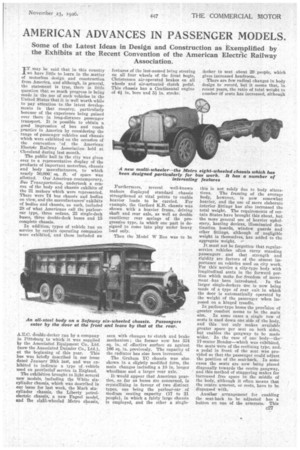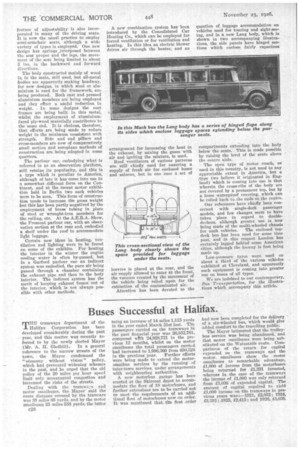AMERICAN ADVANCES IN PASSENGER MODELS.
Page 49

Page 50

If you've noticed an error in this article please click here to report it so we can fix it.
Some of the Latest Ideas in Design and Construction as Exemplified by the Exhibits at the Recent Convention of the American Electric Railway Association.
IT may be said that in this country we have little to learn in the matter of motorbus design and construction from America, and although, in general, the statement is true, there is little question that so much progress is being made in tbe use of such vehicles in the United States that it is well worth while to pay attention to the latest develapments in that country, particularly because of the experience being gained over there in long-distance passenger transport. It is possible to obtain a good impression of bus and coach practice in America by considering the range of passenger vehicles and chassis which were exhibited on. the occasion of the convention of the American Electric Railway Association held at Cleveland during last month.
The public hall in the city was given over to a representative display of the products of important motorbus, chassis and body manufacturers, to which nearly 50,000' sq. ft. of space was allotted. Our American contemporary, Bus Transportation, undertook a census of the body and chassis exhibits of the 31 makers which were represented. There were 74 bus chassis and bodies on view, and the manufacturers' exhibits of bodies and chassis, as such, included 28 of what Americans call the parlourcar type, three sedans, 23 single-deck buses, three double-deck buses and 15 complete chassis.
In addition, types of vehicle run on service by certain operating companies were 'exhibited, and these included an
A.E.C. double-decker rim by a company in Pittsburg to which it was supplied by the Associated Equipment Co.. Ltd. (now the Associated Daimler Co., Ltd.), at the beginning of this year. This bus was briefly described in our issue dated January 26th last, and was exhibited to indicate a type of vehicle used on proVincial service in England.
The exhibition brought to light several new models, including the White sixcylinder chassis, which was described in our issue for last week, the Mack sixcylinder chassis, the Liberty petrolelectric chassis, a new Fageol model, and he eighl-wheeled Metro chassis, features of the last-named being steering on all four wheels of the front bogie, Christensen air-operated brakes on all wheels and air-actuated clutch pedal. This chassis has a Continental engine of 41 in. bore and 51 in. stroke.
Furthermore, several well-known makers displayed standard chassis strengthened at vital points to enable heavier loads to be carried. For example, the Garford K.B. chassis was shown with a heavier frame, driving shaft and rear axle, as well as double cantilever rear springs of the progressive type, in which one part is designed to come into play under heavy load only.
Then the Model W Reo was to be seen with changes to clutch and brake mechanism ; the former now has 834 sq. in. of effective surface as against 166 sq. in. previously. The capacity of the radiator has also been increased.
The Graham YC chassis was also shown in a slightly modified farm, the main changes including a 10 in. longer wheelbase and a larger rear axle.
It would appear that American practice, so far as buses are concerned, is crystallizing in favour of two distinct types, one being the parlour-car of medium seating capacity (17 to 21 people), in which a fairly large chas-sis is employed, and the other a single
decker to seat about 29 people, which gives increased headroom.
, There are few radical changes in body design to record, but it seems that, in recent years, the ratio of total weight to number of seats has increased, although this is not solely due to body altera
tions. The framing of the average body, however, is now somewhat heavier, and the use of more elaborate interior fittings has also increased the total weight. The requirements of certain States have brought this about, but the more general use of heavier upholstery, heating devices, illuminated destination boards, window guards and other fittings, although of negligible weight in themselves, has added to the aggregate weight. —
It must not be forgotten that regularservice vehicles often carry standing passengers and that strength and rigidity are factors of the utmost importance on vehicles used on city work. For this service a city-type body with longitudinal seats in the forward portion which make for freedom of move ment -has been introduced. In the larger single-deckers use is now being made of a type of rear exit in which the door is automatically operated by the weight of the passenger when imposed on a hinged treadle.
In parlour-type buses the provision of greater comfort seems to be the main aim. In some cases a single row of seats is used down one side of the body, and this not only makes available. greater space per seat on both sides, but enables the gangway. to be made wider. In the ease of one body—the17-seater Bender—which was exhibited, the seats were of the reclining type, and_ a pedal in front of the seat was provided so that the passenger could adjust the position of the seat-back. In some cases the seats are now being placed diagonally towards the centre gangway, and this method of staggering makes for increased free space in the middle of the body, although it often means that the centre armrest, or rests, have to be dispensed with.
Another arrangement for enabling the seat-back to be adjusted has a button on one of the armrests. This feature of adjustability is also incorporated in many of the driving seats. It is now the usual practice to employ semi-armchair seats, although a wide variety of types is employed. One new design has springs interposed between the seat proper and the legs, the movement of the seat being limited to about 3 ins. in the backward and forward directions.
The bOdy constructed mainly of wood is, in the main, still used, but all-metal bodies are apparently making headway, for new designs, in which steel or aluminium is used for the framework, are being produced. Both oast and pressei aluminium members are being employed and they effect a useful reduction in weight. In some designs the seat frames are being built in this metal. whilst the employment of aluminiumfaced ply-wood materially contributes. to the same end. It is obvious, therefore, that efforts are being made to reduce weight to the minimum consistent with
strength. Side and end pillars and cross-members are now of comparatively small section and aeroplane methods of construction are being adopted in some quarters.
The parlour ear, embodying what is referred to as an observation platform, still retains its popularity, and this is a type which is peculiar to America, although of late it has come into use in a somewhat different form on the Continent, and at the recent motor exhibition held in Berlin two such vehicles were to be seen. This form of construction tends to increase tire gross weight but this has been partly negatived by the employment of beam tubing in place of steel or wrought-iron members for the railing, etc. At the A.E.R.A. Show, the Fremont parlour car, with an observation section. at the rear end, embodied a shelf under the roof to accommodate light luggage.
Certain new ideas in heating, ventilation and lighting were to be found on some of the exhibits. For heating the interior in the winter the engine coolingwater is often by-passed, but in a Garford parlour car an indirect system was embodied, the pure air being passed through a chamber containing the exhaust pipe and then to the body interior. The indirect system has the merit of keeping exhaust fumes out of the interior, which is not always possible with other methods.
A new combination system has been introduced by the Consolidated Car Heating Co., which can be employed for forced ventilation or for ventilation and heating. In this idea an electric blower drives air through the heater, and an arrangement for increasing the heat in the exhaust, by mixing the gases with air and igniting the mixture, is used.
Roof ventilators of various patterns are still chiefly used for ensuring a supply of fresh air for enclosed buses and saloons, but in one case a set of louvres is placed at the rear, and the air supply allowed to enter at the front, the vacuum created by the movement of the vehicle being relied upon for the extraction of the contaminated air.
Attention has been devoted to the question of luggage accommodation on vehicles used for touring and sight-seeing, and in a new Lang body, which is shown in two accompanying illustrations, the side panels have hinged sections which enclose fairly capacious compartments extending into the body below the seats. This is made possible by raising the level of the seats above the centre aisle.
The open type of motor coach, as used in this country, is not used to any appreciable extent in America, but a itype (we believe it originated in England) which is coming into use is that wherein the cross-ribs of the body are not covered by a permanent top, but by a loose waterproof covering, which can be rolled back to the ends or the centre.
Our references have chiefly been concerned with single-deck passenger models, and few changes seem to have taken place in regard to doubledeckers, although greater use is now being made of the multi-wheeled chassis
for such vehicles. The enclosed topdeck bus has been used for some time past, and in this respect London has certainly lagged behind some American cities, although the leeway is fast being made up.
Low-pressure tyres were used on about a third of the various vehicles exhibited at Cleveland, and apparently such equipment is coming into greater use on buses of all types.
We are indebted to our contemporary, Bus Transportation, for the illustrations which accompany this article.












































































































